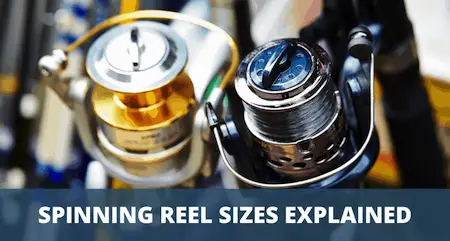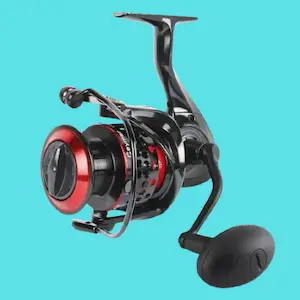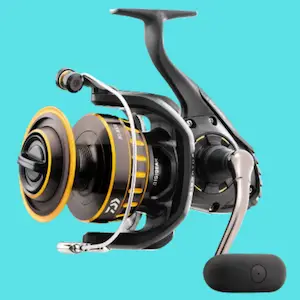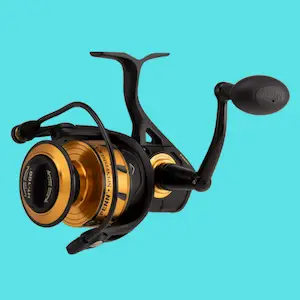Spinning Reel Size Chart (Choose The Best Size Reel For Your Purpose)
UPDATED 03 NOVEMBER 2023
by Robert Ceran
Once you’ve decided to buy a new spinning reel, the first thing you need to do is figure out what the best reel size is for your purpose.
Combined with all the other factors you need to consider when choosing a new reel, this is an additional level of complexity that you may be tempted to ignore.
But keep in mind that choosing the right size spinning reel is just as important as getting the right model, and it’s not as complicated as it might seem.

Just follow this guide, and check our spinning reel size chart below to find the perfect size reel for your purpose.
What size spinning reel do I need?
The ideal size spinning reel you should get is determined by the type of fishing you plan to do. Among the most important things to consider are:
- Will you be fishing in freshwater or saltwater?
- What size fish are you planning to catch?
- What line strength are you planning to use?
In general, saltwater spinning reels are larger than freshwater reels, since they need to handle stronger lines, and bigger fish.
They also need to have greater line capacity, since strong saltwater species tend to make long ‘runs’ after being hooked, which would pull all the line off a small reel.
It intuitively makes sense that if you will be pursuing larger fish, then your spinning reel needs to be larger too.
For example, if you’re fishing for crappie and bluegill, you would be fine with a size 1000 spinning reel, whereas catching tuna is better done with a much larger size of reel, such as a size 10,000 spinning reel.
The easiest way to determine the right size for your purpose is to look at our fishing reel size chart below, and to check which one is best for your fishing tactic.
Spinning reel sizes explained
If you’re wondering what does reel size mean, the first thing to know is that spinning reels sizes can be confusing because there are two different size classifications that are both in use.
Some reel manufacturers classify their spinning reel sizes as 10, 20, 30, etc., while other reel manufacturers classify them as size 1000, 2000, 3000, and so on.
But there’s actually no need to get confused about this, since the two systems are basically the same. For example, a reels size 10 corresponds to a reel size 1000, and a size 25 corresponds to size 2500, and so on.
In other words, you only need to pay attention to the first two numbers of the reel size, without worrying about the zeros behind it, and then compare this number across all brands and models that you’re interested in.
Spinning reel size chart
Small sized spinning reels (1000 – 3500)
These are small spinning reels ideal for lightweight rods in the 6-7 foot range. They are best for targeting small species up to about 15 pounds, and work best with 2-10lb monofilament, or 4-14lb braid. While they are mostly used for freshwater fishing, they can also be put to use in protected coastal waters.
| Reel Size | Recommended Mono Line Strength | Recommended Braid Line Strength | Recommended Applications | Recommended Species (North America) |
|---|---|---|---|---|
| 1000 (or 10) | 2-4lb (1-2kg) | 4-8lb | Ultralight fishing in freshwater and estuaries, bays & harbors | Trout, Crappie, Bluegill, Yellow Perch |
| 2000 (or 20) | 4-6lb (2-3kg) | 4-8lb | Ultralight fishing in freshwater and estuaries, bays & harbors | Bass, Trout, Crappie, Bluegill, Yellow Perch |
| 2500 (or 25) | 5-8lb (2.5kg-4kg) | 5-12lb | Light fishing in freshwater and estuaries, bays & harbors | Bass, Walleye, Northern Pike |
| 3000 (or 30) | 6-10lb (3kg-5kg) | 6-14lb | Light fishing in freshwater and estuaries, bays & harbors | Bass, Walleye, Northern Pike, Catfish |
| 3500 (or 35) | 6-10lb (3kg-5kg) | 6-14lb | Light fishing in freshwater and estuaries, bays & harbors | Bass, Walleye, Northern Pike, Catfish |
Table 1: Sizes 1000-3500
If you’re specifically interested in ultralight fishing, check out our review on the best ultralight spinning reel.
Medium sized spinning reels (4000 – 5500)
These are medium sized spinning reels ideal for rods in the 7-8 foot range.
They are best for targeting mid sized species up to about 30 pounds, and work best with 8-14lb monofilament, or 10-25lb braid.
They are often used for heavier freshwater applications, or for inshore saltwater fishing (such as redfish fishing).
| Reel Size | Recommended Mono Line Strength | Recommended Braid Line Strength | Recommended Applications | Recommended Species (North America) |
|---|---|---|---|---|
| 4000 (or 40) | 8-12lb (4kg-6kg) | 8-20lb | Medium fishing in freshwater and inshore saltwater | Catfish, Muskie, Snook, Redfish, Snapper |
| 4500 (or 45) | 8-12lb (4kg-6kg) | 8-20lb | Medium fishing in freshwater and inshore saltwater | Catfish, Muskie, Snook, Redfish, Snapper |
| 5000 (or 50) | 10-14lb (5kg-7kg) | 10-25lb | Medium fishing in freshwater and inshore saltwater | Catfish, Muskie, Snook, Redfish, Snapper |
| 5500 (or 55) | 10-14lb (5kg-7kg) | 10-25lb | Medium fishing in freshwater and inshore saltwater | Catfish, Muskie, Snook, Redfish, Snapper |
Table 2: Sizes 4000-5500
If you’re currently looking for a new spinning reel, check out our review on what is the best Penn spinning reel?
Large sized spinning reels (6000 – 30000)
These are heavy sized spinning reels ideal for heavy rods used for offshore boat fishing, surf casting, or rock fishing.
They are great for targeting large species up to about 150+ pounds (such as tarpon), and work best with 12-60lb monofilament, or 24-100lb braid.
They are ideal for heavy saltwater applications, and the largest models are used to catch pelagic big game species such as sailfish.
| Reel Size | Recommended Mono Line Strength | Recommended Braid Line Strength | Recommended Applications | Recommended Species |
|---|---|---|---|---|
| 6000 (or 60) | 12-16lb (6kg-8kg) | 12-30lb | Medium fishing in inshore & offshore saltwater | Striped Bass, Salmon, Snook, Redfish (Red Drum) |
| 6500 (or 65) | 12-16lb (6kg-8kg) | 12-30lb | Medium fishing in inshore & offshore saltwater | Striped Bass, Salmon, Snook, Redfish (Red Drum) |
| 7000 (or 70) | 14-18lb (7kg-9kg) | 15-40lb | Medium fishing in inshore & offshore saltwater | Striped Bass, Salmon, Snook, Redfish (Red Drum) |
| 7500 (or 75) | 16-20lb (8kg-10kg) | 20-50lb | Medium fishing in inshore & offshore saltwater | Striped Bass, Salmon, Snook, Redfish (Red Drum) |
| 8000 (or 80) | 16-20lb (8kg-10kg) | 20-50lb | Medium fishing in inshore & offshore saltwater | Wahoo, Roosterfish, Dorado, Barracuda, Amberjack |
| 8500 (or 85) | 18-22lb (9kg-11kg) | 30-50lb | Medium fishing in inshore & offshore saltwater | Wahoo, Roosterfish, Dorado, Barracuda, Amberjack |
| 9000 (or 90) | 18-22lb (9kg-11kg) | 30-50lb | Medium fishing in inshore & offshore saltwater | Wahoo, Roosterfish, Dorado, Barracuda, Amberjack |
| 9500 (or 95) | 20-25lb (10kg-12.5kg) | 30-50lb | Medium fishing in inshore & offshore saltwater | Wahoo, Roosterfish, Dorado, Barracuda, Amberjack |
| 10,000 (or 100) | 20-25lb (10kg-12.5kg) | 30-60lb | Medium/Heavy fishing in inshore & offshore saltwater | Tuna, Wahoo, Dorado, Shark |
| 10,500 (or 105) | 22-27lb (11kg-13.5kg) | 30-60lb | Medium/Heavy fishing in inshore & offshore saltwater | Tuna, Wahoo, Dorado, Shark |
| 12,000 (or 120) | 28lb+ (14kg+) | 30-60lb | Medium/Heavy offshore saltwater fishing | Tuna, Wahoo, Dorado, Shark |
| 14,000 (or 140) | 28lb+ (14kg+) | 30-60lb | Medium/Heavy offshore saltwater fishing | Tuna, Wahoo, Dorado, Shark |
| 16,000 (or 160) | 32lb+ (16kg+) | 40-70lb | Medium/Heavy offshore saltwater fishing | Tuna, Wahoo, Dorado, Shark |
| 16,000 (or 160) | 36lb+ (18kg+) | 40-70lb | Medium/Heavy offshore saltwater fishing | Tuna, Wahoo, Dorado, Shark |
| 18,000 (or 180) | 36lb+ (18kg+) | 40-70lb | Medium/Heavy offshore saltwater fishing | Tuna, Wahoo, Dorado, Shark |
| 20,000 (or 200) | 40lb+ (20kg+) | 50-80lb | Heavy offshore saltwater fishing | Sailfish, Tuna (large species), Tarpon, Giant Trevally |
| 25,000 (or 250) | 50lb+ (25kg+) | 50-80lb | Heavy offshore saltwater fishing | Sailfish, Tuna (large species), Tarpon, Giant Trevally |
| 30,000 (or 300) | 60lb+ (30kg+) | 80-100lb | Heavy offshore saltwater fishing | Sailfish, Tuna (large species), Tarpon, Giant Trevally |
Table 3: Sizes 6,000-30,000
How do you match a spinning reel with a rod?
If you’re buying your first spinning reel and rod, you may be confused about matching spinning reel to rod.
The first thing you need to do is look specifically for spinning rods, since their design is different from that of a baitcasting rods, and a baitcasting rod can’t be used with a spinning reel, and vice versa.
On most rods, you’ll find a couple of numbers listed just above the grip. These include the length of the rod, and next to it the strength of line that the manufacturer recommends using with it.
For example, if the rod lists a line strength of 6-10 lbs, this means they recommend using it with a 6 to 10 pound test line. Unless stated otherwise, this number refers to monofilament line strength.
Once you know the recommended line strength on your rod, you can then use our reel size chart to choose a spinning reel that works well with the same line strength, and there you go – you’ve paired your rod and to the right reel.
In the example above, a rod designed to function best with 6-10 lbs line strength would pair well with a 3000 spinning reel.
When you’re done pairing the right rod and reel, you are ready to put fishing line on the reel. Refer to our guide on how to spool a spinning reel in order to do this correctly. You’ll probably also want to familiarise yourself with the different parts of a spinning reel, which will help you to understand the best way to use it and maintain it.
3000 or 4000 spinning reel?
A 3000 size spinning reel is more suitable for medium sized fish (such as bass or pike), due to being lighter in weight, while a 4000 is better for bigger fish (such as muskie), or for saltwater fishing. The lightness of a 3000 reel is especially important if you’re planning to throw lures a lot, which quickly gets exhausting with a heavier model.
Also, since a 4000 size reel comes with a bigger spool and line capacity, this enables a greater casting distance, as well as working better with heavier lines. In general, I never go above a size 3000 for freshwater fishing, while a size 4000 is my go-to choice for inshore saltwater fishing.
What is the best size spinning reel for bass fishing?
One of the most popular uses of spinning reels is for catching bass (both largemouth and smallmouth). However, the best size reel for bass fishing can’t be given as a single size, but rather as a range of recommended sizes in the chart below.
Spinning reel size for bass:
| Reel Size | Recommended Mono Line Strength | Recommended Braid Line Strength |
|---|---|---|
| 2000 | 4-6lb (2-3kg) | 5-10lb |
| 2500 | 5-8lb (2.5-4kg) | 5-12lb |
| 3000 | 6-10lb (3-5kg) | 6-14lb |
| 3500 | 6-10lb (3-5kg) | 6-14lb |
Table 4: Best sizes for bass
The exact size spinning reel sizing for bass depends more on the technique you’ll be using. For example for finesse fishing, you’ll want to use a 2000 size spinning reel. This size works very well with ultralight lures, which is perfect for finesse applications.
On the other hand, if you’re using larger lures, such as crankbait, you’ll probably want to go for a larger reels size such as a 3000 or even a 3500.
There’s a common misconception among anglers that you need a larger fishing reel size to catch larger bass, but this really isn’t true, since bass don’t do very long ‘runs’ like saltwater game fish. Because of this, you can tire out an 8 pound bass on a 2000 spinning reel without any problems.
If you’re not sure what size to go for, just choose a 2500 or 3000 spinning reel, which puts you square in the middle of the range.
What size reel should you use for surf fishing?
Surf casting reels are usually in the range of 5000 to 8000 size spinning reels, with the most common choice being a 6000 size spinning reel.
This puts surf casting reels right at the transition from medium to large sized spinning reels. One reason why surf casting reels need to be on the larger side is that they require a large spool with large line capacity, in order to allow greater casting distance.
Surf fishing can encompass a wide range of applications, ranging from the pursuit of small snappers to big and strong fish like striped bass, or even sharks that come close to the shore.
Because of this, it’s difficult to make a specific recommendation for the best surf fishing reel size, and you’ll need to adjust the size according to the species that you want to target.
What size reel should you use for an ultralight rod?
The ideal reel size for ultralight rods is 1000 to 2500. A 1000 reel comes with the advantage of being the most lightweight option, but also has a significantly smaller line capacity, which tends to limit your casting distance.
So while a 2500 reel is a little heavier, the extra line capacity of its spool makes it a better choice if you need to cast lures in open water, where casting distance can be of critical importance. On the other hand, if you’ll be fishing mostly in small creeks or ponds, a 1000 reel will deliver enough casting distance for your purposes.
Conclusion
This concludes our fishing reel sizing guide. We hope it will help you to choose the perfect size reel for your purpose, and enable you to reel in some trophy sized fish!
If you’re thinking about buying a new reel, check out our recommendations of the top spinning reel under $100, as well as the top spinning reel under $50.
Finally, if you’re in the market for a new reel, also take a loot at our discussion of other types of fishing reels, and the pros and cons of baitcasting vs spinning reels.




